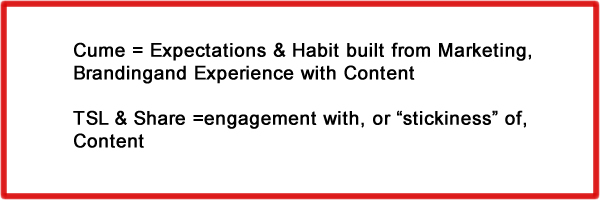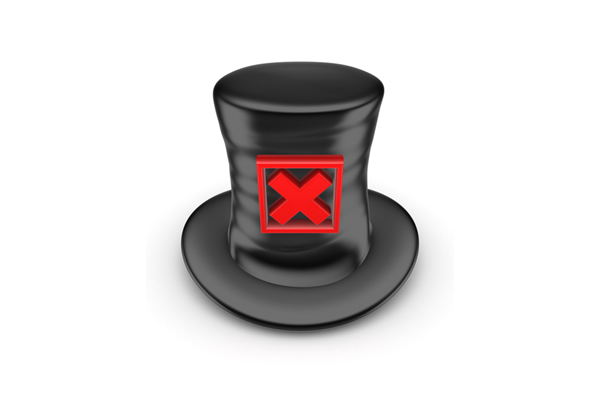Research Decoded #3: Share Delight

Continuing our journey through the jungle of research jargon, we now come to TSL & Average Audience/Share.
Last time, we explored how it all starts with Cume
But what happens next ? Once you’ve stimulated a flow of listeners coming through the door? Is a healthy Share the ultimate measure of programming success? We’ll also talk to Brad March on this burning question.
TSL (Time Spent Listening) and Share are bonded together, because the former drives the latter. But firstly …
Definitions
Once again, from Gfk’s 2015 Radio Ratings Tool Kit for the official word.
BTW I’m focussing on the ratings diary methodology, because it’s the currency in both Australian (metro/major regional) and NZ markets. Though other methodologies, like phone interviews and people-meters, are still aiming to achieve similar goals, just through different means.
TSL
An estimate of the amount of time a station’s Cumulative audience spends listening during a specified time period, expressed in hours and minutes. Note that TSL does not denote audience size. e.g. between 5.30am and midnight, Mon-Fri, Station C listeners tune in for 8 hours and 15 minutes (8:15).
The fun already begins here, on how to extend TSL – can you “make” people listen longer? More below.
Average Quarter-Hour Audience (000s)
The average number of listeners tuned to a radio station per quarter hour, in any given time period. Usually expressed in thousands (000’s). e.g. in any given quarter-hour between Mon-Fri 5.30am to 9am, on average 55,000 listeners were listening to Station F.
Note the word Average. Like TSL this can vary widely between narrower dayparts and demographics. Should always be analysed in more detail for a clearer picture – without going too far in the other direction of over-analysis course!
Share%
What everyone looks at first on the survey day scoreboard.
The percentage of total radio listening audience during a given time period tuning to a particular station. Share is a station’s average audience expressed as a percentage of the total radio audience for the same period. e.g. 8.4% of all radio listening is to Station G, Mon-Sun, 5.30am to midnight.

The Eternal Triangle
Managing this is one of the trickiest parts of a Content Director’s role, among others. And often built into performance contracts – no pressure!
On one side is the need to keep growing Cume, on another is the challenge of increasing TSL. And the third is how the first two interact to produce a successful Share.
And just to add to the balancing act, Cume and TSL are two different beasts, in how you approach them in detail.
When Worlds Collide
Cume is all about instant gratification.
When a listener hits your frequency, especially in flicking situations like in-car, ideally they should immediately hear what they came for.
There’s no time to waste in getting to the point. Whether it’s a new listener attracted by marketing, out of idle boredom, or a habit built by previous positive experiences. You must deliver – now – or they’re gone again. You may not even get a diary-recall credit if you let them down.
TSL and the resulting Share, comes from a Cume listener deciding to hang around and leave you on for a period, up to hours at a time.

There’s a more in-depth exploration of listening drivers in one of my previous articles
 What’s The Content Director’s Ultimate Measure?
What’s The Content Director’s Ultimate Measure?
Let’s ask Brad March, who knows from successful experience as both a Content Director up to the highest Group level, and a CEO managing CDs, what to look for …
“To answer the question you really have to ask why do we measure ratings in the first place ?
The reason is that they are a guide for advertisers and in particular advertising agencies.
Traditionally Share was the measurement used for Agency sales and Cume more for Direct sales.
Whilst Share has always been the most important for agencies and still is, more and more these days Cume is becoming important also.
Advertisers and Agencies are most concerned with reach. The number of listeners, users or viewers a medium reaches is what’s important to them.
Reach or Cume measurement allows for better comparisons with other media for buyers.
It’s fair to say that when measuring a Content Director’s performance, the conversion of Cume to Share is a good indicator to look at. Although music format, breakfast, competitive landscape, marketing etc also come into play.
And on ratings Share, it’s worth CDs remembering that in metro markets here, the 10+ Error Margin is up to 2%. So if you are rating a 10% share you could actually be an 8% or a 12% share ! “
And The Trick Is ?
Programmers have always agonised over how you stimulate longer TSL – what’s the trick or silver bullet? And there’ve been some bizarre attempts like giving a time-call later than what it is, so the diary-keeper ticks off the next quarter-hour as well as the current one!

No Tricks!
After decades of programming & researching the effects of strategies, I can tell you there’s no amount of superficial manipulation of programming clocks, “quarter-hour maintenance” , and mind-games, that will make the slightest difference to what happens in diary-keeping.
Yes it’s essential to create forward momentum, stimulate curiosity and tease ahead to what’s coming up in content. Creating a sense of lots to look forward to. That’s all part of the craft and theatre of engaging radio.
But what is critical to underpin the creative execution, is your deep understanding of your target audience, and their lifestyle and media & entertainment habits. Then structuring your content to fit.
Your target listeners will give you longer TSL only when their lifestyle and work-patterns allow, and your content delivers on expectations.
Most adult music stations make a big play for workplace listening because that’s a logical time, backed by forensic examination of individual diaries, when you’ll be credited with long runs of quarter-hours. There’s no channel-hopping, just the one station to fit the occasion.
Also, being someone’s primary breakfast station choice, whether a talk or music station, generates both Cume and TSL and often sets up workday listening and drive. It’s just simply how it works, by weight of numbers.
Come In Spinner …
As an extreme, but graphic example of balancing Cume and TSL strategy, you might imagine a CHR (Contemporary Hit Radio) station, positioned as the #1 Hit Station (creative eh?), literally playing nothing but the #1 Hit of the day. Pure position, instant delivery of the promise every time!
But unlistenable for any longer than the 3.5 minutes of the tune, so TSL is minimal – just all Cume.
To make it more comfortable for leaving on longer, you start mixing in some other songs – but how many others? At the other extreme, why not play thousands of other songs, every one ever made in your genre, so there’s no repetition? The result being all TSL (for a small loyal core), but a rapidly dwindling Cume, because it always sounds awful when flicking through.
This is the black art of fulfilling the Cume promise, while also being listenable for longer – but not to the point where you lose definition, quality and instant gratification value. Where that point is located, comes down to research, experience and judgement in your particular format .
Cume Conversion
Is another common term that measures how efficiently a station converts its Cume into Share.
I divide the Average Quarter-Hour 000’s over Cume 000’s (as a % to make it readable) for a ratio number. A simple way to compare a station and its competitors. There’s no other mathematical significance – just the higher the number the better.
Because to significantly increase your Share, you have the choice of either improving your Conversion, and therefore TSL OR increasing Cume. The latter takes a lot of Cume to move the Share needle. In practice it usually takes some sort of combination of both.
The challenge here is that it’s unrealistic to project a Conversion rate much higher than your competitors, because each format has limitations, such as female-CHR lower TSL/Conversion, male-Rock higher TSL/Conversion.
Unless you have a game-changing ace up your sleeve, like poaching your competitor’s top-rating show or exploiting an obvious format gap.

Modelling
To project the effects of changing each Cume/Conversion/Share variable I’ve developed an Excel Cume-Share/ Share- Cume Calculator where you can plug in your desired Cume or Share plus a Conversion Rate to see what happens, and what will it take to achieve your goal.
To demonstrate one simple example …
· Station X has 200,000 Cume, Conversion Ratio of 3.4, and Share of 5.7%
· Direct competitor Station Y has 230,00 Cume, Conversion Ratio of 4.5, and Share of 8.6%
· X is behind on both Cume and Conversion/Share – so what will take to at least equal Y’s Share? Which may well be built on a great breakfast show.
Note: this does not factor in Y losing Share to X, just simply what X theoretically needs to gain. In the real world Y would most likely lose some Cume and Share to Y, if X goes for a big push.
Scenario 1
- X does not improve its Conversion ratio which stays the same on 3.4. It needs a massive 103,276 Cume increase to reach an 8.6% Share. A fantasy, if content is the same old.
Scenario 2
- X improves content for a stronger Conversion ratio of 4.5, the same as Y, but still has to add another, but achievable 30,000 Cume for an 8.6% Share. This is the most practical option – requiring focussed execution and efficient use of marketing resources. The good news here is that TSL and Cume will work together – helping each other grow.
Scenario 3
- X plans for a higher Conversion ratio than Y through Content, and not spending anything on external marketing. Problem is you can’t rely only on Conversion/TSL to improve Share.
- And unfortunately it’s all too common to expect a product team to deliver a larger Share, without some kind of Cume-Marketing support. Called preaching to the converted and not growing the congregation.
- Just doesn’t make sense to focus on just one and not support the other. It’s a never-ending Kaizen (Continuous Improvement) process on both .
Takeout Exercise
· What’s your Cume Conversion ratio?
· Is it higher or lower than your direct competitor(s)?
· If lower, what can you do improve TSL through Content?
· What can you do externally, to also continuously support Cume?
Eriks Celmins is Managing Director of Third Wave Media, international consultant for research, strategy and content.Full Member of Australian Market& Social Research Society (AMSRS).LinkedIn


